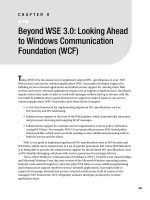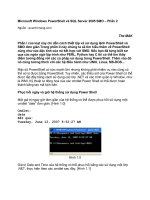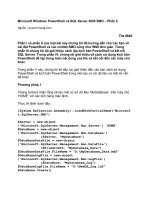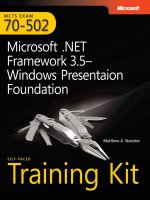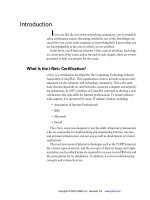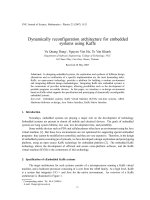Tài liệu Essential Windows Communication Foundation (WCF): For .NET Framework 3.5 doc
Bạn đang xem bản rút gọn của tài liệu. Xem và tải ngay bản đầy đủ của tài liệu tại đây (8.44 MB, 605 trang )
Praise for Essential Windows Communication Foundation
“Resnick, Crane, and Bowen have surveyed the essence of Microsoft’s Web services
platform. Whether this is the first time or the fifty-first time you’re using WCF, you’ll
learn something new by reading this book.”
—Nicholas Allen, Program Manager, Web Services, Microsoft
“As developers, we are constantly called upon to be ‘instant experts’ in many areas.
When the time comes for you to begin working with distributed systems develop-
ment and messaging in the new Microsoft .NET 3.x world, you find yourself con-
fronted by the new 800-pound gorilla called Windows Communication Foundation
(WCF). This is the book you want sitting on your desk when that day comes.”
—Ron Landers, Senior Technical Consultant, IT Professionals, Inc.
“Designing and writing distributed applications was one of the most complex and
frustrating challenges facing .NET developers and architects. What technologies do
you pick? There were so many choices and so little coding time. Windows Com-
munication Foundation (WCF) solves this problem as the single unified platform
to build distributed applications for .NET. Like any distributed system, WCF has a
lot of choices and possibilities. This book provides an easy-to-digest approach that
answers the spectrum of choices with real-world explanations and examples. Start-
ing with the basics of WCF and building from there, this book answers the how you
can use WCF today. It’s a must-read for application developers and architects build-
ing any type of distributed application.”
—Thom Robbins, Director of .NET Platform Product Management, Microsoft
“Essential Windows Communication Foundation (WCF) is a truly comprehensive
work that presents the technology in a clear, easy to read, yet comprehensive man-
ner. The book will be an invaluable asset for both the advanced reader and new-
comer to WCF.”
—Willy-Peter Schaub, Technology Specialist,
Barone, Budge, and Dominick Ltd., Microsoft MVP
“It’s clear the authors drew on years of distributed applications development to dis-
till and present the essence of WCF. The result is a book full of practical informa-
tion designed to save you time and guide you on your WCF project. The chapter on
diagnostics alone will save you hours of troubleshooting and frustration. Highly
recommended.”
—Yasser Shohoud, Technical Director, Microsoft Technology Center, Dallas
This page intentionally left blank
Essential
Windows
Communication
Foundation
Microsoft .NET Development Series
John Montgomery, Series Advisor
Don Box, Series Advisor
Brad Abrams, Series Advisor
The Microsoft .NET Development Series is supported and developed by the leaders and experts of
Microsoft development technologies including Microsoft architects. The books in this series provide a core
resource of information and understanding every developer needs in order to write effective applications
and managed code. Learn from the leaders how to maximize your use of the .NET Framework and its
programming languages.
Titles in the Series
Brad Abrams, .NET Framework Standard Library
Annotated Reference Volume 1: Base Class Library and
Extended Numerics Library, 0-321-15489-4
Brad Abrams and Tamara Abrams, .NET Framework
Standard Library Annotated Reference, Volume 2: Networking
Library, Reflection Library, and XML Library, 0-321-19445-4
Chris Anderson, Essential Windows Presentation Foundation
(WPF), 0-321-37447-9
Keith Ballinger, .NET Web Services: Architecture and
Implementation, 0-321-11359-4
Bob Beauchemin and Dan Sullivan, A Developer’s Guide to
SQL Server 2005, 0-321-38218-8
Don Box with Chris Sells, Essential .NET, Volume 1:
The Common Language Runtime, 0-201-73411-7
Keith Brown, The .NET Developer’s Guide to Windows
Security, 0-321-22835-9
Eric Carter and Eric Lippert, Visual Studio Tools for Office:
Using C# with Excel, Word, Outlook, and InfoPath,
0-321-33488-4
Eric Carter and Eric Lippert, Visual Studio Tools for
Office: Using Visual Basic 2005 with Excel, Word, Outlook,
and InfoPath, 0-321-41175-7
Mahesh Chand, Graphics Programming with GDI+,
0-321-16077-0
Steve Cook, Gareth Jones, Stuart Kent, Alan Cameron
Wills, Domain-Specific Development with Visual Studio
DSL Tools, 0-321-39820-3
Krzysztof Cwalina and Brad Abrams, Framework Design
Guidelines: Conventions, Idioms, and Patterns for Reusable
.NET Libraries, 0-321-24675-6
Len Fenster, Effective Use of Microsoft Enterprise Library:
Building Blocks for Creating Enterprise Applications and
Services, 0-321-33421-3
Sam Guckenheimer and Juan J. Perez, Software
Engineering with Microsoft Visual Studio Team System,
0-321-27872-0
Anders Hejlsberg, Scott Wiltamuth, Peter Golde, The C#
Programming Language, Second Edition, 0-321-33443-4
Alex Homer and Dave Sussman, ASP.NET 2.0 Illustrated,
0-321-41834-4
Joe Kaplan and Ryan Dunn, The .NET Developer’s Guide to
Directory Services Programming, 0-321-35017-0
Mark Michaelis, Essential C# 2.0, 0-321-15077-5
James S. Miller and Susann Ragsdale, The Common
Language Infrastructure Annotated Standard, 0-321-15493-2
Christian Nagel, Enterprise Services with the .NET
Framework: Developing Distributed Business Solutions
with .NET Enterprise Services, 0-321-24673-X
Brian Noyes, Data Binding with Windows Forms 2.0:
Programming Smart Client Data Applications with .NET,
0-321-26892-X
Brian Noyes, Smart Client Deployment with ClickOnce:
Deploying Windows Forms Applications with ClickOnce,
0-321-19769-0
Fritz Onion with Keith Brown, Essential ASP.NET 2.0,
0-321-23770-6
Fritz Onion,
Essential ASP.NET with Examples in C#,
0-201-76040-1
Fritz Onion, Essential ASP.NET with Examples in Visual
Basic .NET, 0-201-76039-8
Scott Roberts and Hagen Green, Designing Forms
for Microsoft Office InfoPath and Forms Services 2007,
0-321-41059-9
Dr. Neil Roodyn, eXtreme .NET: Introducing eXtreme
Programming Techniques to .NET Developers, 0-321-30363-6
Chris Sells and Michael Weinhardt, Windows Forms 2.0
Programming, 0-321-26796-6
Dharma Shukla and Bob Schmidt, Essential Windows
Workflow Foundation, 0-321-39983-8
Guy Smith-Ferrier, .NET Internationalization:
The Developer’s Guide to Building Global Windows
and Web Applications, 0-321-34138-4
Will Stott and James Newkirk, Visual Studio Team System:
Better Software Development for Agile Teams, 0-321-41850-6
Paul Vick, The Visual Basic .NET Programming Language,
0-321-16951-4
Damien Watkins, Mark Hammond, Brad Abrams,
Programming in the .NET Environment, 0-201-77018-0
Shawn Wildermuth, Pragmatic ADO.NET: Data Access
for the Internet World, 0-201-74568-2
Paul Yao and David Durant, .NET Compact Framework
Programming with C#, 0-321-17403-8
Paul Yao and David Durant, .NET Compact Framework
Programming with Visual Basic .NET, 0-321-17404-6
For more information go to www.informit.com/msdotnetseries/
For .NET Framework 3.5
Steve Resnick
Richard Crane
Chris Bowen
Essential
Windows
Communication
Foundation
Upper Saddle River, NJ • Boston • Indianapolis • San Francisco
New York • Toronto • Montreal • London • Munich • Paris
Madrid • Cape Town • Sydney • Tokyo • Singapore • Mexico City
Many of the designations used by manufacturers and
sellers to distinguish their products are claimed as
trademarks. Where those designations appear in this
book, and the publisher was aware of a trademark
claim, the designations have been printed with initial
capital letters or in all capitals.
The authors and publisher have taken care in the
preparation of this book, but make no expressed or
implied warranty of any kind and assume no respon-
sibility for errors or omissions. No liability is assumed
for incidental or consequential damages in connection
with or arising out of the use of the information or pro-
grams contained herein.
The publisher offers excellent discounts on this book
when ordered in quantity for bulk purchases or special
sales, which may include electronic versions and/or
custom covers and content particular to your business,
training goals, marketing focus, and branding inter-
ests. For more information, please contact:
U.S. Corporate and Government Sales
(800) 382-3419
For sales outside the United States please contact:
International Sales
Visit us on the Web: informit.com/aw
Library of Congress Cataloging-in-Publication Data:
Resnick, Steve.
Essential Windows Communication Foundation
(WCF) / Steve Resnick, Richard Crane, Chris Bowen.
p. cm.
Includes index.
ISBN 0-321-44006-4 (pbk. : alk. paper) 1. Applica-
tion software—Development. 2. Microsoft Windows
(Computer file) 3. Web services. 4. Microsoft .NET.
I. Crane, Richard. II. Bowen, Chris. III. Title.
QA76.76.A65R46 2008
005.2’768—dc22
2007049118
Copyright © 2008 Pearson Education, Inc.
All rights reserved. Printed in the United States of
America. This publication is protected by copyright,
and permission must be obtained from the publisher
prior to any prohibited reproduction, storage in a
retrieval system, or transmission in any form or by any
means, electronic, mechanical, photocopying, record-
ing, or likewise. For information regarding permis-
sions, write to:
Pearson Education, Inc
Rights and Contracts Department
501 Boylston Street, Suite 900
Boston, MA 02116
Fax (617) 671 3447
ISBN-13: 978-0-321-44006-8
ISBN-10: 0-321-44006-4
Text printed in the United States on recycled paper at
Courier in Stoughton, Massachusetts.
First printing, February 2008
Editor-in-Chief
Karen Gettman
Acquisitions Editor
Joan Murray
Development Editors
Sheri Cain
Chris Zahn
Managing Editor
Gina Kanouse
Project Editor
Betsy Harris
Copy Editor
Barbara Hacha
Indexer
Tim Wright
Proofreader
Paula Lowell
Technical Reviewers
Nicholas Allen
Jeff Barnes
Keith Brown
Tom Fuller
John Justice
Ron Landers
Steve Maine
Willy-Peter Schaub
Sowmy Srinivasan
Publishing Coordinator
Kim Boedigheimer
Cover Designer
Chuti Prasertsith
Compositor
Nonie Ratcliff
To my parents for pointing me in the right direction, to Zamaneh for making
the journey so sweet, and to Noah and Hannah for showing me the future.
—Steve
Dedicated to my loving wife, Nicki, my son, Matthew, and my daughter,
Charlotte. Thank you for your support and understanding. I love you all
very much and look forward to spending more time together.
—Rich
Thank you to my wife, Jessica, and my daughters, Deborah and Rachel, for
their love and understanding as I again devoted long nights and weekends
to research and writing. We have a book we can be proud of, but now I’m
going to enjoy catching up on that missed family time.
—Chris
This page intentionally left blank
Contents
Foreword xxv
Preface xxvii
Acknowledgments xxxiii
1 Basics 1
Why WCF Matters 1
Introduction 3
Implementing a WCF Service 6
Just the ABCs 7
Writing a WCF Service Entirely in Code 7
Writing a Service with Code and Configuration Files 10
More on Configuration Files 12
More on Service Hosting 13
Exposing the Metadata Exchange (MEX) Endpoint 14
Implementing a Client for a WCF Service 18
Writing a WCF Client Entirely in Code 18
Writing a Client with Code and Configuration 19
Hosting a Service in IIS 23
Discussion 23
Hosting a Service in IIS in Three Steps 24
Implementing a WCF Client for an ASMX Service 27
Tools Support 27
Generating Client Proxy Class and Configuration Files 28
ix
2 Contracts 33
Service Contracts 37
Synchronous Request-Response Operations 38
Asynchronous Request-Response Operations 41
One-Way Operations 44
Duplex Operations 46
Multiple Contracts and Endpoints in a Service 54
Names of Operations, Types, Actions, and Namespaces in WSDL 57
Data Contracts 60
Defining XML Schema for a .NET Class 62
Defining Class Hierarchies 65
Exposing Additional Types in WSDL with KnownTypes 67
Versioning Data Contracts 72
Data Contract Equivalence 75
Working with Collections 76
Message Contracts 78
Typed Messages 79
Untyped Messages 82
Using SOAP Headers with Untyped Messages 85
3 Channels 91
Channel Shapes 94
One-Way Communication Pattern 94
Duplex Communication 95
Request-Reply Communication 97
Shape Changing 98
Operation Contract and Channel Shapes 99
Channel Listeners 101
Channel Factories 102
ChannelFactory<> 104
ICommunicationObject 105
4 Bindings 111
Choosing an Appropriate Binding 116
Sample Application 119
Contents
x
Cross-Machine Communication Between .NET Applications 123
netTcpBinding 123
Local Machine Communication Between .NET Applications 127
netNamedPipeBinding 128
Communication Using Basic Web Services 131
basicHttpBinding 132
Communication Using Advanced Web Services 135
wsHttpBinding 137
ws2007HttpBinding 140
wsDualHttpBinding 143
Comparing Binding Performance and Scalability 152
Communication Using Queued Services 154
netMsmqBinding 155
msmqIntegrationBinding 165
Creating a Custom Binding 168
User-Defined Bindings 171
Binding Elements 171
Transports 172
Encoders 173
Security 174
Transport Upgrades/Helpers 175
Shape Change 176
Other Protocols 177
Exposing a Service Contract over Multiple Bindings 177
5 Behaviors 181
Concurrency and Instancing (Service Behavior) 184
Default Concurrency and Instancing with Sessionless Binding 187
Multithreading a Single Instance 189
Implementing a Singleton 190
Session-Level Instances 193
Controlling the Number of Concurrent Instances 195
Controlling the Number of Concurrent Calls 199
Controlling the Number of Concurrent Sessions 201
Exporting and Publishing Metadata (Service Behavior) 204
Contents xi
Implementing Transactions (Operation Behavior) 207
Transactional Operations Within a Service 208
Flowing Transactions Across Operations 215
Choosing a Transaction Protocol—OleTx or WS-AT 221
Transaction Service Behaviors 223
Implementing Custom Behaviors 224
Implementing a Message Inspector for Service Endpoint Behavior 227
Exposing a Parameter Inspector for Service Operation Behavior
as an Attribute 230
Exposing a Service Behavior Through Configuration 233
Security Behaviors 237
6 Serialization and Encoding 241
Serialization Versus Encoding 241
Comparing WCF Serialization Options 243
DataContractSerializer 243
NetDataContractSerializer 247
XmlSerializer 249
DataContractJsonSerializer 252
Choosing a Serializer 254
Preserving References and Cyclical References 254
Sharing Type with the NetDataContractSerializer 260
Roundtrip Serialization Using IExtensibleDataObject 264
Serializing Types Using Surrogates 270
Streaming Large Data 276
Using the XmlSerializer for Custom Serialization 277
Custom XmlSerialization Using Attributes 278
Custom XmlSerialization Using IXmlSerializable 279
Choosing an Encoder 281
Text Versus Binary Encoding 282
Sending Binary Data Using MTOM Encoding 283
Getting to Know the WebMessageEncoder 284
7 Hosting 287
Hosting a Service in Windows Process Activation Services 288
Hosting a Service in IIS 7 292
Contents
xii
Enabling ASMX Features in an IIS-Hosted Service 294
Self-Hosting 301
Self-Hosting in a Managed Windows Service 302
Hosting Multiple Services in One Process 305
Defining Service and Endpoint Addresses 308
8 Security 315
WCF Security Concepts 316
Authentication 316
Authorization 316
Confidentiality 317
Integrity 317
Transport and Message Security 317
Certificate-Based Encryption 319
Concepts 319
Setup 320
Transport-Level Security 322
Encryption Using SSL 323
Client Authentication 327
Service Identity 332
Message-Level Security 334
Authenticating with wsHttpBinding 335
Securing Services with Windows Integrated Security 340
Section Examples Introduction 341
Authenticating Users with Windows Credentials 343
Authorizing Users with Windows Credentials 346
Authorization Using AzMan 348
Impersonating Users 353
Securing Services over the Internet 358
ASP.NET Integration 360
Authentication Using Membership Providers 361
Role-Based Authorization Using Role Providers 364
Using Forms Authentication 366
Logging and Auditing 371
Contents xiii
9 Diagnostics 375
Sample WCF Application 376
Tracing 376
End-to-End Tracing 377
Activities and Correlation 378
Enabling Tracing 379
Verbosity Recommendations 381
Message Logging 381
Enabling Message Logging 381
Additional Configuration Options 383
Shared Listeners 384
Message Filters 384
Trace Source Auto Flushing 385
Performance Counters 386
Windows Management Instrumentation (WMI) 387
Using the Service Configuration Editor 387
Tracing Options 389
Logging Options 389
Configuring Sources 390
Configuring Listeners 391
Service Trace Viewer 393
Activity View 393
Project View 395
Message View 395
Graph View 395
Analyzing Logs from Multiple Sources 397
Filtering Results 400
10 Exception Handling 403
Introduction to WCF Exception Handling 404
WCF Exception Communication via SOAP 404
Unhandled Exception Example 405
Detecting and Recovering a Faulted Channel 408
Communicating Exception Details 409
Managing Service Exceptions with FaultException 411
Using FaultCode and FaultReason to Extend FaultException 412
Contents
xiv
Limitations of Basic FaultExceptions 414
Creating and Consuming Strongly Typed Faults 415
Declaring Fault Definitions with FaultContract 415
Defining a FaultContract 417
Throwing a FaultException<> with a Defined FaultContract 418
Fault Contract Strategies 419
Implementing Client Fault Handlers 419
Error-Handling Application Block 420
Exception Shielding 421
11 Workflow Services 423
Integration Points 424
Calling a WCF Service from WF 426
Using a Send Activity 427
Writing a Custom Activity 430
Exposing a Service from WF 433
Define the Interface 434
Receive Activity 435
Configuration in app.config 439
Hosting a Service-Enabled Workflow 441
Self-Hosting a Service-Enabled Workflow 442
Hosting a Service-Enabled Workflow in IIS 443
Correlation and Durable Services 444
Long-Running Workflow 445
Handling the Context 450
Persisting Workflow State on the Server 452
Controlling Access to Service-Enabled Workflows 454
Declarative Access Control 455
Programmatic Access Control 455
12 Peer Networking 459
Approaches to Building Distributed Applications 459
Client/Server Applications 460
N-Tier Applications 460
Peer-to-Peer Applications 461
Comparison of Distributed Approaches 462
Contents xv
Peer-to-Peer Applications 462
Mesh Networks 462
Resolving Peer Meshes 464
Message Flooding Versus Directional Messaging 464
Creating Peer-to-Peer Applications 465
netPeerTcpBinding 465
Resolving Peers Using PNRP 468
PNRP Bootstrap Process 469
Windows Internet Computer Names 469
PnrpPeerResolver 470
Mesh Authentication 471
Registering Names Using PNRP 471
System.Net.Peer 472
Implementing a Custom Peer Resolver 474
Limiting the Number of Hops for a Message 478
Collaboration Using Windows Vista 480
People Near Me 481
Windows Contacts 482
Invitations 483
System.Net.PeerToPeer.Collaboration 485
Directional Messaging Using Custom Binding 492
13 Programmable Web 503
All About the URI 504
The Ubiquitous GET 506
Format Matters 507
Web Programming with WCF 507
URI and UriTemplates 508
Building URIs 509
Parsing URIs 510
Creating Operations for the Web 511
Hosting Using WebHttpBinding 512
Using WebGet and WebInvoke 514
WebGet 514
WebInvoke 514
Contents
xvi
Programming the Web with AJAX and JSON 516
ASP.NET AJAX Integration 516
Using the WebOperationContext 523
Hosting for the Web 530
WebScriptServiceHost 530
WebScriptServiceHostFactory 530
Content Syndication with RSS and ATOM 531
Appendix Advanced Topics 537
Publishing Metadata Endpoints 537
mexHttpBinding 538
mexNamedPipeBinding 538
mexTcpBinding 538
mexHttpsBinding 539
Creating Clients from Metadata 539
Creating Silverlight Clients from Metadata 541
Sharing Ports Between Services 542
Configuring Service Quota Settings 543
Configuring HTTP Connections 545
Recycling Idle Connections 546
Adjusting Connection Lifetime 546
Disabling HTTP Keep-Alives 547
Increasing Number of Connections 549
Configuring TCP Connections 549
Recycling Idle Connections 549
Adjusting Connection Lifetime 550
Increasing Number of Connections 550
Using LINQ with WCF 550
Exposing LINQ-to-SQL Entities 550
Index 553
Contents xvii
This page intentionally left blank
Figures
Figure 1.1: Communication between client and service 4
Figure 1.2: Communication between client and service endpoints 5
Figure 1.3: Hosting a service 6
Figure 1.4: Obtaining metadata through MEX endpoint 15
Figure 1.5: Visual Studio generating client proxy class and configuration file 21
Figure 2.1: High-level translation of code artifacts to WSDL 37
Figure 2.2: High-level translation of code syntax to WSDL 38
Figure 2.3: Synchronous request-response communication 38
Figure 2.4: Specifying asynchronous methods in Add Service Reference 42
Figure 2.5: Asynchronous request-response communication 43
Figure 2.6: Duplex communication 47
Figure 2.7: High-level translation of code artifacts to XSD 61
Figure 2.8: High-level translation of code syntax to XSD 62
Figure 2.9: Specifying message contracts in Add Service Reference 80
Figure 3.1: Channel stack 93
Figure 3.2: One-way communication 95
Figure 3.3: Duplex communication 96
Figure 3.4: Request-reply communication 97
Figure 3.5: ICommunicationObject state diagram 107
xix
Figure 4.1: Binding Explorer 115
Figure 4.2: Selecting a binding 118
Figure 4.3: Average response time 153
Figure 4.4: Operations per second 153
Figure 4.5: Cost per operation 154
Figure 5.1: Behavior elements 183
Figure 5.2: Output from default InstanceContextMode and ConcurrencyMode with
sessionless binding 189
Figure 5.3: Output from InstanceContextMode.Single and ConcurrencyMode.
Multiple 191
Figure 5.4: Output from singleton: InstanceContextMode.Single and
ConcurrencyMode.Single 192
Figure 5.5: Output from session-aware service 196
Figure 5.6: Output controlling the number of concurrent instances 199
Figure 5.7: Output controlling the number of concurrent calls 202
Figure 5.8: Output controlling the number of concurrent sessions 204
Figure 5.9: ACID transaction within an operation 209
Figure 5.10: Output from transactional service showing local and distributed
transaction IDs 214
Figure 5.11: Output from optimized transactional service 215
Figure 5.12: Transaction that spans service boundaries 216
Figure 5.13: Output from two transactional services coordinated in a single
transaction 221
Figure 5.14: Interfaces for building custom behaviors on the client 225
Figure 5.15: Interfaces for building custom behaviors on the server 225
Figure 6.1: XML Information Set 242
Figure 6.2: XSD types 244
Figure 7.1: WAS architecture 289
Figure 7.2: Enabling Windows Process Activation Services 290
Figure 7.3: Enabling WCF non-HTTP activation 290
Figure 7.4: IIS implemented on WAS 293
Figure 7.5: Service control manager 305
Figure 7.6: Viewing address and binding from a running service 311
Figures
xx
Figure 8.1: Configuring IIS 7 for SSL 324
Figure 8.2: Services over corporate LAN with Windows application 341
Figure 8.3: Configuring an XML Authorization store 349
Figure 8.4: Creating a role definition with Authorization Manager 350
Figure 8.5: Authorization Manager showing example configuration 351
Figure 8.6: Services over Internet with Windows application 359
Figure 8.7: Sample Internet application 359
Figure 8.8: Services over Internet with Web application 367
Figure 9.1: Tracing and MessageLogging enabled 388
Figure 9.2: Advanced Message Logging settings 389
Figure 9.3: Message Logging XPath Filter 390
Figure 9.4: Trace Source settings 391
Figure 9.5: Listener settings 392
Figure 9.6: Detailed listener configuration 392
Figure 9.7: Service Trace Viewer with client trace and message logs 394
Figure 9.8: Service Trace Viewer Message view 396
Figure 9.9: Service Trace Viewer Graph view 396
Figure 9.10: Service Trace Viewer with service and client logs loaded 398
Figure 9.11: Service Trace Viewer graph of activity transfer 399
Figure 9.12: Service Trace Viewer with expanded subtract call activity 400
Figure 9.13: Creating a custom filter in the Service Trace Viewer 401
Figure 10.1: FaultException returned by calling service with zero denominator 407
Figure 10.2: CommunicationObjectFaultedException for faulted channel 407
Figure 10.3: Exception detail included with ServiceDebugBehavior 410
Figure 11.1: WF behaviors 426
Figure 11.2: Adding a Send activity to a workflow design surface 428
Figure 11.3: Proxy type was imported so an operation can be chosen 429
Figure 11.4: Binding WF variable to service operation parameters 430
Figure 11.5: Using a custom activity in a workflow 433
Figure 11.6: Adding a Receive activity to the workflow design surface 436
Figure 11.7: Entering or importing an interface for a Receive activity 437
Figure 11.8: Binding operation contract parameters to workflow variables 438
Figures xxi
Figure 11.9: Workflow exposing one Receive activity 439
Figure 11.10: Composite Receive activity in a long-running workflow 446
Figure 11.11: Completing a long-running workflow 448
Figure 11.12: One client maintaining context with multiple calls to a
workflow instance 451
Figure 11.13: Multiple clients maintaining context with multiple calls to a
workflow instance 452
Figure 11.14: Declarative authorization within a Receive activity 456
Figure 12.1: Client/server model 460
Figure 12.2: Three-tier model 461
Figure 12.3: Peer model with three nodes 461
Figure 12.4: Fully connected mesh 463
Figure 12.5: Partially connected mesh 464
Figure 12.6: Windows Internet Computer Name (WICN) 470
Figure 12.7: Number of hops across connected nodes 479
Figure 12.8: People Near Me Control Panel 481
Figure 12.9: Allow invitations 482
Figure 12.10: Windows Contacts 482
Figure 12.11: Windows Contact Properties 483
Figure 12.12: Windows Meeting Space invitation 484
Figure 12.13: Windows Meeting Space invitation details 484
Figure 12.14: Peer Chat sample application 485
Figure 12.15: Enabling Teredo using NetSh 500
Figure 13.1: Response in browser using WebHttpBinding binding 514
Figure 13.2: XBOX 360 Game Review AJAX-enabled application 517
Figure 13.3: Wallpaper Web application 524
Figure A.1: Starting Net.Tcp Port Sharing Service from command line 543
Figure A.2: IIS 7.0 settings for HTTP Keep-Alives 548
Figure A.3: LINQ-to-SQL Object Relational Designer 551
Figures
xxii
Tables
Table 1.1: Options for Generating Proxy Class and Configuration File 28
Table 2.1: WSDL Elements 35
Table 2.2: Paired One-Way Versus Duplex Contracts for Bidirectional
Communication 48
Table 2.3: WCF Attributes That Override Default WSDL Names 58
Table 3.1: Channel Shapes Based on OperationContract Attributes 100
Table 4.1: WCF Communication Bindings in .NET Framework 3.5 112
Table 4.2: Supported Features of Each Binding 117
Table 4.3: netTcpBinding Binding Properties 124
Table 4.4: netNamedPipeBinding Binding Properties 129
Table 4.5: basicHttpBinding Binding Properties 133
Table 4.6: WS-* Specifications Supported by the wsHttpBinding Binding 136
Table 4.7: wsHttpBinding Binding Properties 137
Table 4.8: WS-* Specifications Supported by the ws2007HttpBinding
Binding 140
Table 4.9: ws2007HttpBinding Binding Properties 141
Table 4.10: wsDualHttpBinding Binding Properties 144
Table 4.11: netMsmqBinding Binding Properties 156
Table 4.12: msmqIntegrationBinding Binding Properties 166
Table 5.1: Combining InstanceContextMode and ConcurrencyMode 186
Table 5.2: Interaction of TransactionFlow elements 217
xxiii
Table 7.1: Settings for Enabling ASMX Features in a WCF Service 296
Table 7.2: Hosting Choices 312
Table 8.1: Client Authentication with Transport Security 328
Table 9.1: Tracing Source switchValue Options 380
Table 9.2: messageLogging Options 383
Table 12.1: netPeerTcpBinding Binding Properties 466
Table 13.1: URI Examples 505
Table 13.2: Common HTTP Verbs 506
Table 13.3: Web Programming Features in .NET Framework 3.5 508
Table A.1: ServiceThrottlingBehavior Properties 544
Tables
xxiv

